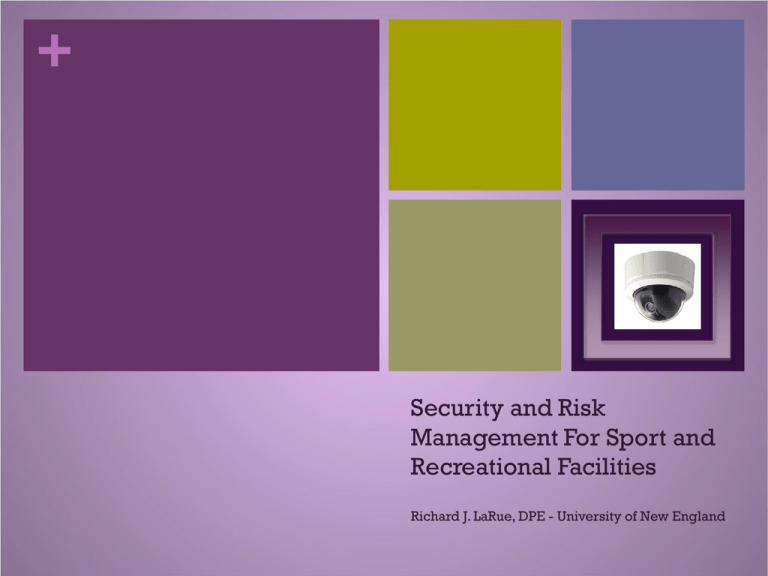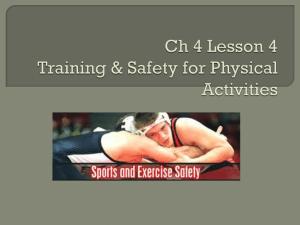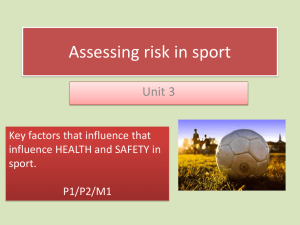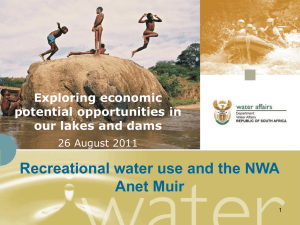Security and Risk Management For Sport and Recreational
advertisement

+ Security and Risk Management For Sport and Recreational Facilities Richard J. LaRue, DPE - University of New England + Briefly, some background regarding this presentation… Applied, interviewed, had my background* checked, and was hired by Guardsmark™ as a security guard. Guardsmark™ is contracted to provide security services for the General Dynamics Armament Division plant in Saco, ME. No less than two guards are on duty, three eight-hour shifts, 52 weeks per year. General Dynamics Corporation is the largest Defense Contractor for the United States Military. *included psychological and drug testing + Security and Risk Management For Sport and Recreational Facilities This presentation will focus upon the issues and challenges of security and risk management in sport and recreational facilities. Specifically, the presentation will consider new technologies that can/should be infused in facility security. Further, the presentation will describe and recommend a comprehensive approach to facility risk management. Part I: The Issues and Challenges of Security and Risk Management in Sport and Recreational Facilities A Brief Overview of Risk Management Concepts o What is Risk Management? o What is the Standard of Care? o What is Forseeability? o What is Negligence? o What are Professional Standards? o What is Certification and Licensure and the Rights and Responsibilities of the Same? Part I: The Issues and Challenges of Security and Risk Management in Sport and Recreational Facilities What is Risk Management? Classic Risk Management Sports and Risk Management The Standard of Care and Forseeability Understanding (as a reasonably prudent person) the Responsibility (duty owed) to Manage Foreseeable Risks (as a professional who is up-to-date) and Do No harm. Negligence Professional Standards; Certification, Licensing and Training Knowing the Professional Rights and Responsibilities of Referees/Officials, Coaches, Athletic Trainers (and other medical personnel), Program Leaders, Facility Staff, Security, etc. with regard to current Certification and/or Licensure and Training. Part I: The Issues and Challenges of Security and Risk Management in Sport and Recreational Facilities The Impact of 9/11 on Security and Risk Management, e.g., the Super Bowl™ after September 11, 2001. Miller, J., Veltri, F., & Gillentine, A. (2008). Spectator Perception of Security at the Super Bowl After 9/11: Implications for Sport Facility Mangers. The Smart Journal, 4,22, pp. 16-25. Current (and Future) Risks Associated with Sport and Recreational Programming; and, the Management of Sport and Recreational Facilities (including Venues). The Changing Nature of Sports Litigation. The Responsibility of Sport and Recreation Managers to Mitigate and/or Manage Forseeable Risks. Part I: The Issues and Challenges of Security and Risk Management in Sport and Recreational Facilities Issues and Challenges That Are More Unique to Sport and Recreation (Facilities and Venues): Camp Security (Especially Resident Camps) Unique Sport Venues: Marathons, Cross-Country Races, Triathlons, Open Water Sports Programs, e.g., boating, Sailing, Waterskiing, Hiking, etc. Regular Inspection and Documented Management of Facilities Related to Activities. Part I: The Issues and Challenges of Security and Risk Management in Sport and Recreational Facilities Issues and Challenges That Are More Unique to Sport and Recreation (Continued): Keeping Track of Participants. Providing Adequate and Appropriate Supervision. Clear and Meaningful Signage. Emergency Preparedness of/for Visitors/Spectators, Participants/Users, and Staff. Part II: New Technology that Can/Should be Infused in Facility Security Surveillance Detection Systems Access Control and Personnel Identification Systems Perimeter Intrusion Detection Systems (PIDS) Emergency and Warning Systems Long Distance (indoor and outdoor) Communication Systems System Integration and Client Networks Guard Tour Checkpoint Station-to-Station Systems Training Solutions Surveillance Detection Systems Security Cameras CCTV Monitor CCTV Network DVR Secure Data Storage Signage Access Control and Personnel Identification Systems Door Control Units ((DCU) Communication System(s) CCTV Camera(s) CCTV Monitor Secure Data Storage Supervision Perimeter Intrusion Detection Systems (PIDS) Security Cameras (day/night, highresolution, power pivot, and lighting) PSRS™ Radar or Infrared Sensors Computer/Monitor Imaging Software System Integration Signage Emergency and Warning Systems Smoke/Fire Alarms, and Annunciators Lightning Detection/Warning Public Address Systems Egress Alarms Signage Long Distance (indoor and outdoor) Communication Systems Radio Systems CB Radio Telephone Systems Public Address Systems Intercom Computer System Integration and Client Networks Existing Networks Upgrading Consultants Systems Security Guard Tour Checkpoint Station-to-Station Systems Guard Tours Checkpoint Stations Integrated Systems Training Solutions Initial Training (Document This) Ongoing Training & Reviews (Document These) Annual Semi-Annual Monthly Weekly Daily Sample Training Topics Part III: A Comprehensive Approach to Facility Risk Management: Establishing/Implementing a Joint Risk Management Program Identify Key Issues and Outcomes Establish a Representative Work Group (include consultants, who are experts, when appropriate). Configure a Timeline and Implement a Review Process Identify Key Issues and Outcomes Who is/are at risk? What are the challenges? When are there risks? Where are the risks? Why manage the risks? [note: this may become part of the mission statement] Who is/are responsible? Establish a Representative Workgroup Administration Program Staff Security Facilities Management Members and other users Experts/Consultants (as needed) Configure a Timeline and Implement a Review Process Retain/Revise Protocol, Policies, and Procedures Identify and Install Selected Systems Integrate Technologies into Existing Protocol Initiate and Facilitate Training Implement Joint Risk Management Program Assess Outcomes Against the Key Issues and Challenges Small Group Initiatives Case 1: ForeseeabilityEstablishing a policy for crowd control. Consider the use of technology as part of this policy. Case 2: ForeseeabilityEstablishing a policy regarding team practices or contests after school cancellations (weather). Small Group Initiatives Case 3: NegligenceEstablishing a policy for Field/Venue crowd management and behavior surveillance. Case 4. Standard of CareEstablishing a policy regarding lightning safety in outdoor facilities/venues. Comments…Sharing… Questions? + Richard J. LaRue, DPE Professor and NAS Fellow Business and Communications University of New England 11 Hills Beach Road Biddeford, ME 04005-9599 rlarue@une.edu






